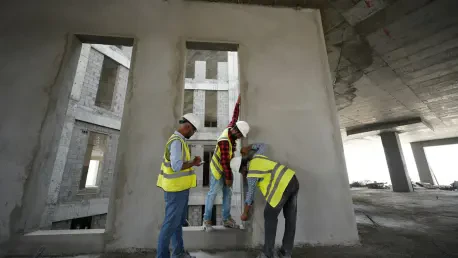The construction industry is undergoing a significant transformation driven by the advancements in predictive analytics and AI-powered tools. With mounting challenges such as labor shortages, rising costs, and increasingly complex projects, traditional construction management methods are becoming outdated. Predictive analytics offers a revolutionary approach to these issues by enhancing human expertise with data-driven insights and proactive solutions. This shift is steering the industry away from intuitive decision-making and towards a method grounded in objective data.
Objective Data Over Subjective Reporting
Predictive analytics is changing the landscape of progress tracking in construction by promoting data-driven approaches over subjective evaluations. One notable example is the use of AI by Buildots, which analyzes 360-degree images from construction sites to identify potential issues before they escalate. While there may be skepticism regarding the precision of AI, firsthand experiences from construction planners, like the instance where a report showed only a 2% discrepancy, help build trust in these systems over time.
By shifting from subjective reporting to data-backed insights, predictive analytics helps in identifying trends and potential problems, reducing the likelihood of critical issues. This shift not only enhances the accuracy of project tracking but also enables quicker and more effective interventions. The use of AI tools in this manner illustrates the potential for predictive analytics to vastly improve the reliability and efficiency of construction management processes.
Integration of Human Involvement with AI
For the optimal balance between technology and human expertise, the construction industry finds that AI tools work best when integrated with experienced professionals. This approach ensures that experts remain actively involved on-site while leveraging sophisticated data analysis to enhance their decision-making processes. As noted by planners like Lee Howlett, maintaining this balance helps in fostering trust and confidence in AI-generated data. It allows professionals to compare insights with their direct observations, ensuring that the information provided by technology aligns with real-world conditions.
Furthermore, this integration encourages a collaborative environment where human judgment and technological data complement each other. The active involvement of professionals in the data collection process ensures that they stay connected to the physical site, preventing any disconnection that might arise from solely relying on AI tools. By maintaining a hands-on approach, professionals can validate or challenge AI-generated insights based on their own experience, which strengthens the accuracy and reliability of the data used in project management.
Transforming Supply Chain Dynamics
Predictive analytics are also instrumental in transforming the dynamics of interactions within the supply chain by fostering transparency and collaboration among all stakeholders. When subcontractors and supply chain partners have access to the same objective data, it minimizes the potential for blame-shifting and promotes cooperative problem-solving. Andy Pritchard of Willmott Dixon Interiors highlights how shared access to transparent data moves discussions from subjective assessments to fact-based dialogues, enhancing performance evaluations and resource allocations.
This transparency leads to more streamlined communication and decision-making processes, benefiting all parties involved. With a clear and mutual understanding of project data, stakeholders can address issues more effectively and work towards common goals. This collaborative approach ensures that resources are allocated efficiently and that any potential bottlenecks or obstacles are addressed proactively, leading to improved project outcomes and stronger relationships within the supply chain.
Supporting, Not Replacing, Human Judgment
A significant theme in the adoption of predictive analytics is the technology’s role in supporting rather than replacing human judgment. Concerns over skill erosion and the impact on team communication are addressed by emphasizing that AI and predictive tools serve to enhance human capabilities, not substitute them. The critical tasks of interpreting data, making decisions, and handling relationships remain firmly within the domain of experienced professionals. Technology offers data-driven suggestions, but the ultimate coordination and resource management depend on human expertise.
This approach ensures that the valuable skills and insights of industry professionals are preserved and utilized effectively. By using technology as a complementary tool, construction teams can benefit from enhanced data analysis while still relying on their judgment and experience to oversee projects. This synergy between human input and technological advancements helps maintain robust communication within teams and ensures that decision-making processes remain informed and balanced.
Enhancing Early Project Stages
Predictive analytics significantly impact the early stages of construction projects by enhancing timelines and improving efficiency. These tools enable proactive planning and tracking, which helps in alleviating stress and mitigating potential issues before they arise. Jeremy Cortesio from Skanska emphasizes the role of predictive analytics in fostering stronger inter-stakeholder relationships and increasing efficiency. By identifying potential challenges early, project teams can address them proactively, leading to smoother project execution and better overall outcomes.
The early implementation of predictive analytics facilitates more accurate project planning and allows for more informed decision-making from the outset. This proactive approach not only improves project timelines but also strengthens communication and collaboration among all parties involved. By identifying potential risks and challenges early, project teams can develop strategies to mitigate them, ensuring that projects stay on schedule and within budget.
Predictive Tendering and Lessons Learned
Beyond immediate project management, predictive analytics extend their benefits to the tendering process and pre-construction planning. By leveraging data from past projects, teams can verify the integrity of programs and identify delivery risks before finalizing contracts. This is a significant shift from the industry’s historical challenge of systematically applying lessons learned from past projects. With predictive analytics, teams can base their planning on verified, project-specific data, leading to more reliable and informed future projections.
Predictive tendering allows for a more thorough evaluation of potential risks and rewards, ensuring that contracts are based on accurate and comprehensive information. This approach leads to better-aligned expectations and more effective risk management strategies. By incorporating lessons learned from previous projects, construction teams can continuously improve their processes and enhance their ability to deliver successful outcomes on future projects.
Proactive versus Reactive Management
The overarching theme in the construction industry is the shift from reactive to proactive management, driven by the adoption of data-driven tools. Professionals are increasingly favoring the approach of preemptively addressing potential issues rather than reacting to crises. While it is recognized that technology alone cannot solve all challenges, the creative and effective application of these tools by skilled professionals is essential for genuine improvement and successful project outcomes.
This shift to proactive management encourages a more strategic and forward-thinking approach to construction projects. By anticipating potential problems and addressing them early, teams can avoid costly delays and disruptions. The effective use of predictive analytics empowers construction professionals to make informed decisions, optimize resource allocation, and ensure that projects are completed on time and within budget. This proactive mindset, supported by advanced technology, represents a significant advancement in the construction industry’s ability to manage complex projects effectively.
Conclusion
The construction industry is experiencing a major transformation, thanks to advancements in predictive analytics and AI-powered tools. Faced with challenges like labor shortages, escalating costs, and increasingly complex projects, traditional construction management methods are becoming more and more outdated. Predictive analytics offers a groundbreaking approach to these issues by enhancing human expertise with data-driven insights and proactive solutions. This evolution is moving the industry away from intuitive decision-making towards methods that are grounded in objective data. By leveraging AI and predictive analytics, companies can anticipate potential problems, optimize resources, and improve the overall efficiency and safety of projects. This allows for more accurate project timelines and cost estimates, ultimately leading to higher quality outcomes and greater client satisfaction. In this new era, the integration of advanced technologies is not just an option but a necessity for staying competitive and meeting the growing demands of the construction sector.









